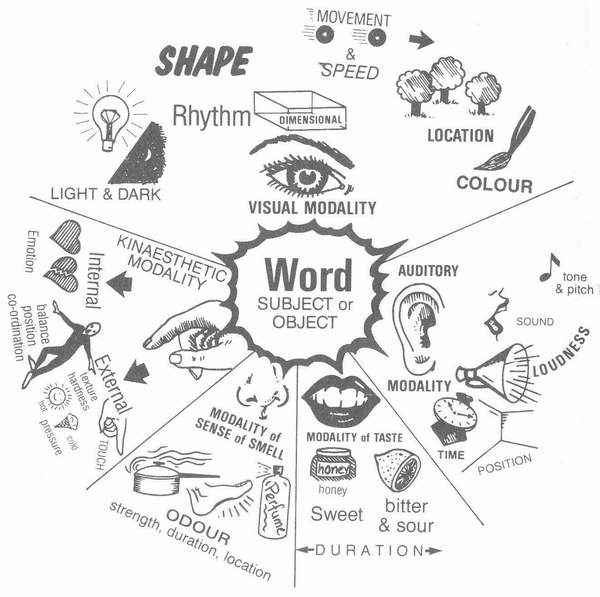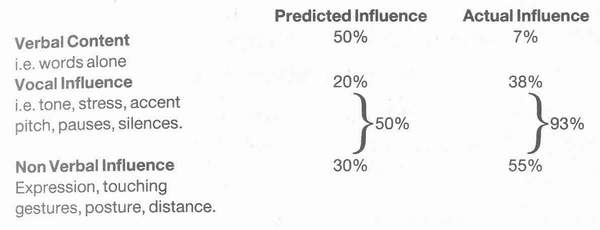
10. The State Of The Art
When we set out to investigate Accelerated Learning some four years ago, many educators were trying to reproduce the methods and results of Dr. Lozanov. Yet his methods were already 15 years old. In the last four years the movement has progressed rapidly.
We found that while none of the recent discoveries about how the human brain and memory works, in any way contradicted Lozanov's principles, there were clear pointers to important areas of development and improvement.
In particular, we frequently heard the comment that Lozanov's methods, when applied to foreign language teaching, were unrivalled for the fast creation of large amounts of vocabulary - but they were less good at teaching grammar. Moreover, Lozanov had heavily emphasised the authority of the teacher as being an important element. This authority flowed from the fact that he or she was the teacher. Yet this made for passivity in the classroom. We, in contrast, had come to the conclusion that active involvement was perhaps the most important element in a class.
The teacher's authority should flow from her manifest ability, not her titular role. Lozanov had also heavily emphasised the role of music (sound association) and it seemed reasonable to ask if there was enough imagery (visual association) in his original version of Accelerated Learning (The version described by Peter Kline in Chapter 7.)
In March, 1984, we had assembled enough information from our investigations to produce an inventory of the elements that would have to be built into an ideal Accelerated Learning Course. The inventory was compiled from our findings on how the brain and memory works, (the subject of Chapters 1-5), from our discussions with Accelerated Learning practitioners from Eastern Europe, Western Europe and the Americas and from our discussions with three consultants on the Accelerated Learning
Movement - Dr. Win Wenger, Paul Hollander and Charles Schmid. It is to the work of the first two that we now turn. We shall then be ready to draw all the threads together.
Articulate!
Win Wenger is an independent lecturer who specialises in certain key aspects of Accelerated Learning. He acknowledges the success of the Lozanov method but points out that it is comparatively weak on the use of visuals and visualisation. Whereas Lozanov's emphasis has been on creating memory, Win Wenger's emphasis is on drawing out that memory and on ways to facilitate subsequent and spontaneous recall. After all, he says the word "Education" is derived from the Latin "educare", which literally means "drawing out". And you can only draw out what is already in there!
I found the time I spent in Win Wenger's company exciting and I acknowledge that it stimulated us to think about some key improvements that have now been built into the new version of Accelerated Learning.
Win Wenger comes back time and again to the thought that we already know much more than we think we do. He starts with a philosophical point. The human body is almost entirely replaced every seven years, so the essence of you is not physical, it is your personality. Your personality is effectively a pattern, a behaviour style combined with your unique knowledge and experiences.
Socrates was the first teacher to confirm that the task of an educator was to draw out information already within the student and thereby to let people teach themselves. Consequently Socrates believed that the main function of a teacher was to teach people to articulate. Articulation not only draws forth existing information, but if you articulate information that is new to you (i.e. describe it in detail out loud) that very act of description sharpens your perception of the subject. It also facilitates and deepens your memory of it.
You can readily prove the point. Take a moment now and stare at some quiet common object in the room. Start describing it out loud and you will discover alI sorts of features in it you never consciously noticed before. We know that the richer the detail you construct and, therefore the more associations you form, the easier it is to remember.
Why should the act of articulation have such a very positive effect on memory? `That's easy' answered Dr. Wenger, `I believe that as much as 80% of the brains function is visual. Visualisation involves the subconscious. If you read something new and then close your eyes and describe it out loud, you by definition are synchronising the activity of your left and right brain - because visualisation is a right brain function and speech is a left brain function. Articulation, therefore, which involves whole brain activity, is a vital element in fast learning.
`I would go further. Articulation is essential to understanding. Let me give an example. Bernstein at Harvard University believes there may be as many as 4 million colours. However, there are fewer than 200 words for colours so there are for all practical purposes, fewer than 200 colours. If you can't articulate something it effectively doesn't exist!'
Bernstein conducted another series of tests with wide implications. He took two groups of young children. One group was educationally severely disadvantaged, with a poor vocabulary. The other group was normally educated. He showed pictures of butterflies to both groups. The butterflies included several different species; some were patterned, some were striped, some had dots of colour on their wings. The children who lacked the words for "stripe" or "dot", literally could not draw these particular butterflies. Without the words their ability to see and understand the relevant concept was strictly limited. Yet when they were subsequently taught the words, they could then draw the correct shapes.
From these thoughts, Win Wenger has produced some impressive ways to improve your ability to visualise, to form images and to develop your power of observation. Nevertheless his simplest concept is perhaps the strongest. Whenever you close your eyes, visualise the subject and articulate that image out loud, you have achieved a left/right brain symbiosis and a fast route into memorisation.
Different Strokes for Different Folks
Paul Hollander, an educational specialist and a consultant to IBM on the advantages and principles of Accelerated Learning, has also been influential on the format in which we have finally produced Accelerated Learning for home use.
Paul Hollander insisted that we needed to recognise the fact that everyone has a preferred learning style and that each Accelerated Learning course should allow for this.
Sensory Systems
Within the last 5-6 years a number of researchers have established the importance of three principle forms of communication between human beings, and demonstrated that these communication styles are mirrored by learning styles.
The principle researchers have been Richard Bandler and John Grinder whose book "Frogs into Princes" has become a classic in the field; Dilts "Neuro-Linguistic Programming" (NLP); and ZanerBloser who published a major report entitled "Teaching through Modality Strength". These books were published in 1979 and the techniques are now generally known as NLP.
The main conclusion was that each person has a dominant sensory system. Thus you may prefer to communicate or learn in either:
A Visual Way - (you are orientated to visualise)
An Auditory Way - (you normally like to hear presentations or talk out problems)
A Kinaesthetic Way - (kinaesthetic means "to do with movement, active, action orientated").
The initials V.A.K. will be used as a shorthand, (Visual, Auditory, Kinaesthetic).
At first sight the analysis may seem obvious - but the implications are significant. If you want to communicate with someone who is highly visual, she will find a lesson that consists only of an audio tape tedious and unsatisfying. Conversely, an auditory learner will benefit less from a presentation that relies purely on slides. Note we are NOT saying that you communicate or learn only with your preferred sense. Clearly we all process information by visual, auditory and kinaesthetic means.
We are saying, however, that learning will be easier and more effective if the elements are expressed in the way you prefer to learn, whether that is V. A. or K.
How you present something is often as important as what you say - and indeed may determine whether it is understood at all.
Psychologist Robert Mehrabian has conducted studies to determine which of 3 elements are the most important in communication during conversation. He asked respondents to predict the relative importance of each and then gave them the actual measured importance. Here are the results:

The medium really is the message!
How to Find your own Preferred Learning Style
There are two main ways. The first is simplistic, but surprisingly accurate. It has to do with the way you habitually express yourself. The chart below will help you relate your normal expressions to your preferred sensory style.
Visual Learners - Will typically say:-
Auditory Learners - will typically say:-
Kinaesthetic Learners - will typically say:-
By matching the teaching approach with the preferred learning approach, we are able to establish a more direct, sympathetic and clear communication. In a real sense, the teacher and pupil are "speaking the same language".
You can establish your dominant sensory system somewhat more specifically by considering the following list and asking which characteristic most represents your personal preferences.


It would be very unusual if your answers fell only in one column, because we are discussing, not exclusive communication and learning styles, but preferred learning styles.
The practical purpose of being able to identify learning styles and preferred sensory systems is to ensure that the ideal learning programme communicates to the learner in all three "modes'.
In this way the learning process will involve the maximum sensory input, and we know that this makes for rich, detailed associations and hence fast memory creation. Moreover, each student will feel comfortable, because one or more of the learning activities is in the style with which he feels most in sympathy.
The extremes of preference, of course, are the artist, the musician and the dancer, and it is clear how you would present information to each one, i.e.
I see your point or
I tune into your argument or
I feel at home with your presentation.
Eye movement clues
It is a curious, and rather charming fact, that we all give off involuntary clues as to the sort of sensory system we prefer to employ or are employing at the moment.
Most attention has been placed on eye movement, because it is the easiest to detect. In fact breathing patterns, muscle tone, vocal tone and, of course, gestures all signal our individual style of communication.
Given a normal right handed person, you will find that their eyes move in a set manner, in response to the six main types of questions. Let's look at these six questions and the reaction they elicit.
| Typical Question | Response | Code |
| 1. When did you last see the Queen on T.V.? | Subject recalls an actual image i.e. remembers a specific scene (visual recall) |
Vr |
|
2. Can you picture an elephant riding a bicycle? |
Subject constructs an image he has never seen before (visual construct) |
Vc |
| 3. What is your favourite song- how does it start? | Subject recalls an actual sound(s) (auditory recall) | Ar |
| 4. Can you imagine the sound of a bath running while your telephone is ringing? | Subject constructs a sound he has probably not heard before (auditory construct) | Ac |
| 5. Think out the two main principles of Accelerated Learning you've learned so far and how you would present the argument to some friends at a dinner party. | Subject is holding an internal conversation or dialogue with himself (auditory dialogue) | Ad |
| 6. How does it feel when you stroke a cat? | Subject recalls an actual sensation - a Kinaesthetic experience. It can be feel, taste, smell. (Kinaesthetic) | K |
If you ask people the above six types of question, their eyes will normally move in the following way. (It is the last shift before they look back at you again that is significant). The movements are depicted as you face the subject.

We can superimpose the six positions for the eye clues on one face to summarise the indicators of the mode in which your partner, or pupil is thinking.
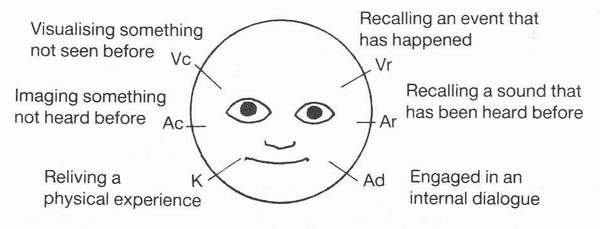
Psychologists have found that these eye movement clues hold good in almost every culture in Europe, Africa and America. (Although for some extraordinary reason the Basque people in North East Spain do not respond typically!)
In addition a dilation of the pupils and a defocusing of the eyes is normally a sign that the person is processing thoughts internally and may well be visualising.
Generally, these eye movement patterns will be reversed for left handed people. Although the patterns are not necessarily true for all right handed persons, nevertheless people who do not follow the above pattern will have a consistent pattern of their own.
Why not practice the set of eye clues below. Match up the statements with the eye clues and put the correct code underneath the pictures.
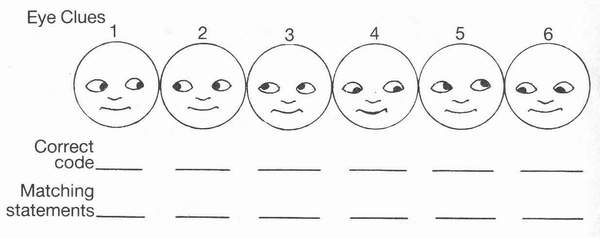
Statements:
A. Let me consider how this affects me
B. I remember he used those exact words C. I feel really happy
D. She really looked good in that dress
E. I'm trying to imagine how it might work
F. Let me tell you how a politician might express it.
Answers:
The Significance of other Body Language
Psychologists have observed other characteristics that also indicate the individuals dominant sensory system. Breathing is especially indicative.
Thus it is common to observe:
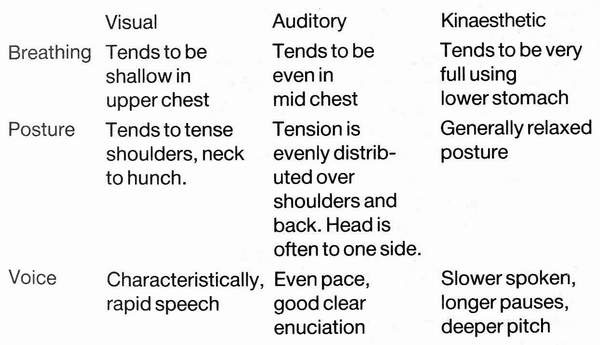
How do Sensory Preferences Affect Learning?
The above analysis has already begun to influence teaching styles to a significant extent.
For example, it has been discovered that good spellers invariably bring to mind an image of the word (V), and can `feel' (K) if it is right. Bad spellers don't use this sequence. They try to check the word phonetically and with English that is a poor predictor of correct spelling!
Consequently it is much more productive to teach a bad speller the sequence of V + K, than it is to ask him or her laboriously to memorise the specific spelling of thousands of words. In other words you have taught the correct principle and that principle holds good in thousands of different situations.
It is important to repeat that no-one is a pure visual or pure auditory or pure kinaesthetic learner. However, we react best to our dominant system. So it pays to train yourself to develop your other senses, in order to maximise the beneficial effect of all the signals reaching you.
It should also be noted that each sensory channel (V.A.K.) has sub-divisions. For instance, the visual `mode' can have colour, or black and white, can be two or three dimensional, and can involve movement. The Auditory mode has loudness, tone and pitch. Once you recognise your strengths and weaknesses you can practice for improvement - any improvement in imagining will improve your ability to learn.
Professional teachers, or people who regularly present to meetings, should take special note of the fact that, when you have presented a significant amount of new information, it is natural for the recipients to start to process that information internally - by looking up in a "visual construct" mode or down in an "auditory dialogue" mode.
To the presenter, this can look like inattention. Many lecturers will instinctively react by increasing the pace and volume of their talk in an attempt to force attention and `hammer the point home'. The result is irritation and a lowering of understanding in the audience.
A better strategy would be to reduce pace. This allows the internal processing to take place and time for a recap.
A teacher who comes to recognise that she or he is a primarily visual communicator, will find a much better rapport if she deliberately introduces Auditory and Kinaesthetic elements into her teaching. Clashes in learning styles versus teaching styles often explain why a child can do poorly one year and then bloom the following year with a new teacher in the same subject.
There is a parallel in respect of left brain/right brain learning. Educational Researcher Bernice McCarthy in her book "The 4-Mat System" has identified four different types of learner.
The "Innovative" learner who is imaginative and relates new information to her or his own experiences.
The "Common Sense" learner who wants realistic examples relevant to real life.
The "Dynamic" learner who wants to learn by actual involvement and specific experiences.
The "Analytical" learner who wants to see the principles and concepts behind the subject.
Only the last type of learner is a natural left brain learner, who finds it comfortable to be verbal and logical and have an auditory presentation of information. The other three types are right brain individuals who will prefer a visual and kinesthetic approach.
Bernice McCarthy is of the opinion that the majority of students start off as right brain dominant - yet the majority of teachers instruct for left brain assimilation. No wonder conventional learning has been a strain!
The conclusion must be clear. The ideal learning method will orchestrate left and right brain activity and employ a full range of visual, auditory and kinesthetic activities to make learning comfortable and to invoke the maximum response.
It is now clear that someone whom we describe as naturally "sensitive", or with whom we have a natural "rapport", is probably only unconsciously communicating to us in the style we like best.
A group of psychotherapists have extended the principle of "rapport" into what is termed "matching" and "leading". When in the company of someone you like, talking at the same pace and tone and moving at the same tempo.
This is often done quite deliberately by a psychiatrist, who will first "match" his clients action, and then gradually "lead" them to a calmer tempo.
The use of Baroque music has a similar function - the relaxing tempo of the music produces a matching physical and mental response in the listener and leads them into a state of relaxed receptivity. Bandler and Grinder - following the work of the brilliant psychotherapists Milton Erickson and Virginia Satir - have evolved a useful technique you can easily use yourself.
It is deceptively simple, and indeed most people's initial reaction is that it is too simplistic to work - but it does.
They asked each member of their class to remember and describe a time when they experienced real pleasure and delight in learning something. It may have been riding a bicycle, suddenly understanding the solution to a problem, or having something explained that was new and really interesting - something they personally felt was fascinating. As the subject recounts this pleasurable experience, a clear change comes over them. Their breathing rate, heart rate, voice tone and often skin colour and posture changes. They have recaptured their original enthusiasm. If the psychotherapist, for example, now touches the individual's wrist or shoulder, their state of mind becomes associated with that signal or as it is termed "anchored". Later that same state of mind can be recaptured by simply triggering the "anchor" - i.e. touching the wrist or shoulder.
It does sound difficult to accept initially but our sub-conscious is simplistic. We find the technique worth repeating for two reasons.
First you can do it for yourself and thereby bring back in an enthusiasm and feeling of pleasurable anticipation for a learning session.
Secondly it is yet further proof that even our deepest and apparently sub-conscious beliefs were once learned and if we choose, can be brought to the surface and changed.
A Specific Learning Pattern
An excellent book on the latest psychology of teaching is "Master Teaching" written by Bernard F. Cleveland.
He has shown that we can each develop a learning sequence that is ideal for us personally. The following sequence incorporates what we have discovered to date and formalises it into a learning sequence. For each new subject you would -
Read the text and visualise the contents Hearthe words internally in your `mind's ear'.
Feel the text, or act out the key elements or in some way physically involve yourself.
Using the new expressions we have learned, the sequences might be:
V - read material
Vr - recall it visually - image it
A - hear a verbal presentation
Ar - hear the material in your head, rehearse it
Vc - construct a new image of the subject in your head, visualise it vividly.
K - Act out the subject or underline key words
V+K - Write out key words in your favourite colour. Draw a picture or map. Write some of the words backwards. Walk around while you read or listen.
Ad- Present the argument to an imaginary audience.
Involve your senses and you will involve your subconscious. Involve your subconscious, and you have the most powerful part of your brain helping in the learning process.
